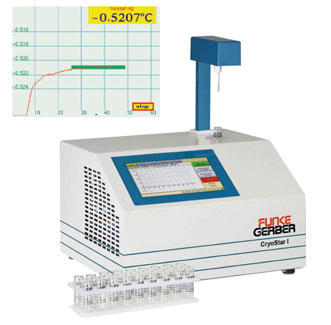 RG strumenti supporta il produttore nella scelta dello strumento ottimale per il controllo dei diversi parametri chimico-fisici del latte destinato al consumo umano
RG strumenti supporta il produttore nella scelta dello strumento ottimale per il controllo dei diversi parametri chimico-fisici del latte destinato al consumo umano
Il latte è l’alimento per eccellenza, il primo che si scopre appena si viene al mondo. È definito un alimento funzionale”, cioè un alimento che non solo nutre, ma protegge il nostro organismo. Questa duplice funzione è legata alla composizione del latte e alle sue caratteristiche intrinseche che devono essere assolutamente preservate e valorizzate.
Tutti i tipi di latte sono costituiti da proteine ad elevato valore biologico, grassi, zuccheri a rapido assorbimento, minerali e vitamine, e altre sostanze importanti: i cosiddetti “componenti funzionali naturali” che dipendono dall’alimentazione dell’animale e dai processi di conservazione successivi alla mungitura.
Per chi lavora e distribuisce questo prezioso alimento diventa importantissimo avere un sistema di controllo della qualità del prodotto in tutte le sue fasi di lavorazione.
RG strumenti è in grado di supportare il produttore nella scelta dello strumento ottimale per il controllo dei diversi parametri chimico fisici del latte destinato al consumo umano, e di quello impiegato nelle successive fasi di produzione dei suoi derivati (formaggi, yogurt, creme ecc.).
Già nella fase di conferimento del prodotto è necessario utilizzare uni strumento chiamato Crioscopio che, in base al punto di congelamento del latte, determina se il prodotto sia stato accidentalmente contaminato con tracce di acqua di lavaggio delle cisterne o degli impianti di mungitura.
Poi, per verificare che il prodotto conferito abbia le caratteristiche richieste dall’acquirente, RG strumenti consiglia di utilizzare il nuovissimo Lactoscan COMBO che in pochi minuti determina sia la percentuale di grassi e proteine che il numero di cellule somatiche presenti.
Se invece il latte deve essere trasformato nei suoi derivati attraverso operazioni di fermentazione, riscaldamento e stagionatura, è necessario mantenere sotto controllo principalmente i parametri di temperatura, pH e acidità.
In particolare, la determinazione dell’acidità è sempre stato un parametro difficile da ottenere a causa del colore opalescente del latte stesso. Attualmente questo parametro è facilmente determinato grazie al Titolatore automatico AT1000. Questo strumento è in grado di misurare l’acidità del prodotto direttamente in gradi SH senza errori dovute alla diversa manualità degli operatori.
RG strumenti commercializza anche una vasta gamma di ph-metri, termometri caseari, termometri per ambiente e data logger per la registrazione di temperatura e umidità nelle celle di stagionatura.
Non ultimo è possibile monitorare le temperature anche durante la fase di trasporto del prodotto verso la rete di distribuzione finale tramite dei registratori di temperatura monouso.
È importante che il produttore di latte sia supportato nella scelta della strumentazione di controllo da uno staff di tecnici in grado di consigliare lo strumento migliore per ogni parametro da monitorare. Il produttore ha infatti la responsabilità di preservare e valorizzare al meglio questo prezioso alimento in modo da garantirne la qualità e la salubrità al cliente finale.
The importance of milk quality
RG strumenti supports the producer in the choice of the optimal instrument for the control of the different chemical and physical parameters of milk for human consumption
Milk is the food par excellence, the first one you discover as soon as you come into the world. It is defined as “a functional food “, a food that not only feed you, but also protects your body.
This dual function is linked to the composition of the milk and its intrinsic characteristics which must absolutely be preserved and enhanced.
All types of milk are made up of high biological value proteins, fats, rapidly absorbed sugars, minerals and other important substances: the so-called “natural functional components” which comes from the animal’s diet and from the conservation processes after milking.
For those who work and distribute this precious food, it becomes very important to have a product quality control system in all its processing phases.
RG strumenti is able to support the producer in the choice of the optimal instrument for the control of the different chemical and physical parameters of milk for human consumption, and of the milk used in its derivatives production phases (cheeses, yoghurt, creams, etc.).
Already in the product delivery phase it is necessary to use an instrument called Cryoscope, this instrument basing on the freezing point of the milk, determines whether the product has been accidentally contaminated with traces of washing water from the tanks or milking systems.
Then, to verify that the delivered product meets the characteristics required by the buyer, RG Strumenti recommends using the new Lactoscan COMBO which in a few minutes determines both the percentage of fats and proteins and the number of somatic cells.
On the other hand, if milk has to be transformed into its derivatives through fermentation, heating and seasoning operations, it is necessary to keep the temperature, pH and acidity parameters under control.
In particular, the determination of acidity has always been a difficult parameter to obtain due to the opalescent colour of the milk itself. Now this parameter is easily determined thanks to the AT1000 automatic titrator. This instrument is able to measure the acidity of the product directly in SH degrees without errors due to the different manual skills of the operators.
RG Strumenti also sells a wide range of ph-meters, dairy thermometers, room thermometers and data loggers for recording temperatures and humidity in the seasoning cells.
Last but not least, temperatures can also be monitored during the transport phase of the product to the final distribution network by means of disposable temperature recorders.
It is important that the milk producers are supported in the choice of control instrumentation by a staff of technicians able to suggest the best instrument for each parameter to be monitored. In fact, the producers have the responsibility of preserving and making the most of this precious food in order to guarantee its quality and healthiness to the final customer.











